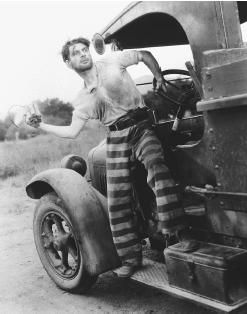Am A Fugitive From A Chain Gang I - Film (Movie) Plot and Review
USA, 1932
Director: Mervyn LeRoy
Production: Warner Bros. Pictures, Inc.; black and white, 35mm; running time: 93 minutes. Released 10 November 1932. Filmed 28 July-7 September 1932 in Warner Bros. studios. Cost: $195,845.
Producer: Hal Wallis; screenplay: Howard J. Green and Brown Holmes, from the autobiography I Am a Fugitive from a Georgia Chain Gang by Robert E. Burns; photography: Sol Polito; editor: William Holmes; art director: Jack Okey; music conductor: Leo F. Forbstein; costume designer: Orry-Kelly; technical advisors: S. H. Sullivan and Jack Miller, uncredited assistance by Robert E. Burns.

Cast: Paul Muni ( James Allen ); Glenda Farrell ( Marie ); Helen Vinson ( Helen ); Noel Francis ( Linda ); Preston Foster ( Pete ); Allen Jenkins ( Barney Sykes ); Edward Ellis ( Bomber Wells ); John Wray ( Nordine ); Everett Brown ( Sebastian ); Hale Hamilton ( The Reverend Robert Allen ); Louise Carter ( Mother ); Sally Blane ( Alice ); Berton Churchill ( Judge ); David Landau ( Warden ); Willard Robertson ( Prison Board Chairman ); Robert McWade ( Attorney ); Robert Warwick ( Fuller ).
Publications
Script:
Green, Howard J., and Brown Holmes, I Am a Fugitive from a Chain Gang , edited by John E. O'Connor, Madison, Wisconsin, 1981.
Books:
LeRoy, Mervyn, It Takes More Than Talent , New York, 1953.
Warner, Jack L., with Dean Jennings, My First Hundred Years in Hollywood , New York, 1964.
Gussow, Mel, Don't Say Yes Until I Finish Talking: A Biography of Darryl F. Zanuck , New York, 1971.
The Warner Bros. Golden Anniversary Book , New York, 1973.
Lawrence, Jerome, Actor: The Life and Times of Paul Muni , New York, 1974.
LeRoy, Mervyn, with Dick Kleiner, Take One , New York, 1974.
Lorentz, Pare, Lorentz on Film: Movies 1927–1941 , New York, 1975.
Roddick, Nick, Warner Bros. in the 1930s: A New Deal in Entertainment , London, 1983.
Articles:
"Article on Robert Burns," in New York Herald Tribune , 27 November 1932.
"Champion of the Underdog," in Silver Screen (New York), December 1932.
LeRoy, Mervyn, "The Making of Mervyn LeRoy," in Films in Review (New York), May 1953.
Campbell, Russell, in Velvet Light Trap (Madison, Wisconsin), June 1971.
Ebert, J., "Kracauers Abbildtheorie," in Filmkritik (Munich), April 1977.
Pulleine, Tim, in Monthly Film Bulletin (London), March 1979.
Siclier, J., in Avant-Scène du Cinéma (Paris), 1 October, 1979.
Cohen, Joan, in Magill's Survey of Cinema 2 , Englewood Cliffs, New Jersey, 1980.
"Mervyn LeRoy 'Revisited'," in Image et Son , no. 378, December 1982.
Checklist and critical notes on Mervyn LeRoy, in Film Dope (Nottingham), no. 35, September 1986.
* * *
During the 1930s Warner Brothers earned a well-deserved reputation of being a studio with a strong social conscience. Hal Wallis, who was production chief at the studio for much of that decade, recalled that "the general impression was that we were very liberal in our selection of material." Among the Warners' productions which helped to create that image was I Am a Fugitive from a Chain Gang , a well-made film that earned the studio's sound department and Paul Muni Oscar nominations. This production ranks, to use the words of film historian Clive Hirschhorn, as "one of the most vehement, eloquent, and far-reaching of social protest films."
I Am a Fugitive from a Chain Gang is based on a book by Robert E. Burns, who recounts his adventures with the prison system in Georgia and his two escapes from the chain gangs. The movie is generally faithful to its sources (although for various reasons Georgia is never mentioned), with some melodramatic flourishes added. The story is deceptively simple: a World War I veteran from a good family returns home after the war and becomes dissatisfied with his circumstances. He takes to the road and becomes innocently involved in a stick-up; found guilty he is sentenced for some years to a chain gang. The film in stark fashion depicts the sadistic brutality and dehumanizing violence with which chain gang inmates are treated. He escapes, goes North, makes something of himself, but is forced into marriage with a woman who has discovered his past; when ultimately he tries to leave her for another woman she denounces him to the authorities. Attempting to clear his record by going South voluntarily to serve a nominal term, he is doublecrossed and returned to the chain gang. He escapes once more, and comes out of hiding one night to see his sweetheart. Restless, fear-ridden, terrified of being returned to the chain gang, he is but a haunted shadow of his former self. In what film critic Pauline Kael has called "one of the great closing scenes in the history of films," he retreats into the shadows at hearing a sound, and responds to his sweetheart's question of how he lives by saying "I steal" as the movie ends.
The film is a harsh indictment of the chain gang, and American movie audiences were made aware of the terrible conditions prevalent in the penal system of the South. Moreover, these audiences were presented with a bleak view of contemporary American life in keeping with the harsh realities of the Great Depression which was just then peaking in terms of its impact on life in the United States. Although the bulk of the film's action is set in the 1920s, the indictment and conditions depicted easily translated to the hard times of the early 1930s. I Am a Fugitive from a Chain Gang , thanks to a thoughtful script, taut direction, and vibrant central performance remains a powerful indictment and pungent commentary on social ills.
—Daniel Leab
Comment about this article, ask questions, or add new information about this topic: